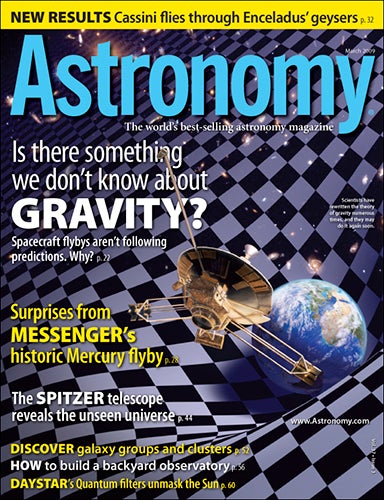
More resources from Astronomy.com:
- Astronomy news
- Astronomy basics
- Glossary of astronomical terms
- Return to Astronomy “For the media” page
January 28, 2009
WAUKESHA, Wis. — For centuries, Sir Isaac Newton’s law of gravity, coupled later with Albert Einstein’s general theory of relativity, provided scientists with their basic understanding of gravity. But today, a number of cosmic oddities is showing astronomers they know less about gravity than they thought. The astronomical unit, a supposed constant, seems to be increasing, while the Pioneer spacecraft that launched in the early 1970s are closer to Earth than they should be.
In “Is there something we don’t know about gravity?” author John D. Anderson, currently a consultant for the Juno and Rosetta space missions, explains how the inflation of the astronomical unit and the unpredicted trajectories of the Pioneer spacecraft — among other oddities — might require a new theory of gravity.
“One thought is that a new physics will explain these observed gravity mysteries,” Anderson said. “Maybe astronomy is already experiencing a transformation to a new physics, or at least a new theory of gravity.”
Pick up the March issue of Astronomy, on newsstands February 6, to learn more about the Pioneer spacecraft and other gravity anomalies.
Two planetary science updates
This past October, both the MESSENGER and Cassini spacecraft completed historic flybys of Mercury and Saturn’s moon Enceladus, respectively. In the March issue, Senior Editor Richard Talcott brings you the latest images and discoveries from each mission.
In “Surprises from MESSENGER’s historic Mercury flyby,” Talcott explains what now having imaged 90 percent of Mercury’s surface means for our knowledge of the innermost planet. And he details Cassini’s close encounter with Saturn’s dynamic moon in “Cassini flies through Enceladus’ geysers.”
“How to build a backyard observatory”
If you’re an amateur astronomer who doesn’t observe as often as you’d like because of the work involved, consider building an observatory close to home — and be sure to use the March issue as a guide. In “How to build a backyard observatory,” Senior Editor Michael E. Bakich offers tips on picking the right size, roof, floor, and more to make your observatory match your needs.
Also in the March 2009 Astronomy
- “How the Spitzer Space Telescope unveils the unseen cosmos” — NASA’s flagship infrared eye in the sky has probed hidden corners of the universe. Spitzer chief scientist Michael Werner shares some of the telescope’s greatest discoveries.
- “Discover galaxy groups and clusters” — With an 8-inch or larger scope and a dark sky, go after these distant citizens of the cosmos.
- “The Sky This Month” — Exclusive pullout star charts will guide you through March’s night sky.
- The March issue of Astronomy also includes Astro News, Bob Berman’s Strange Universe, Glenn Chaple’s Observing Basics, Phil Harrington’s Binocular Universe, Stephen James O’Meara’s Secret Sky, Ask Astro, New Products, and Reader Gallery.









